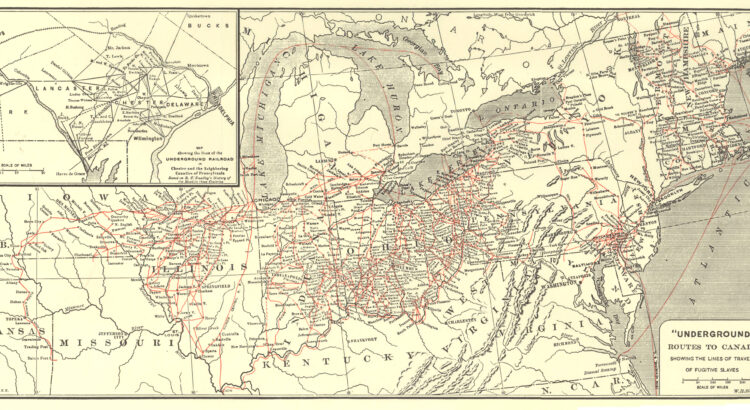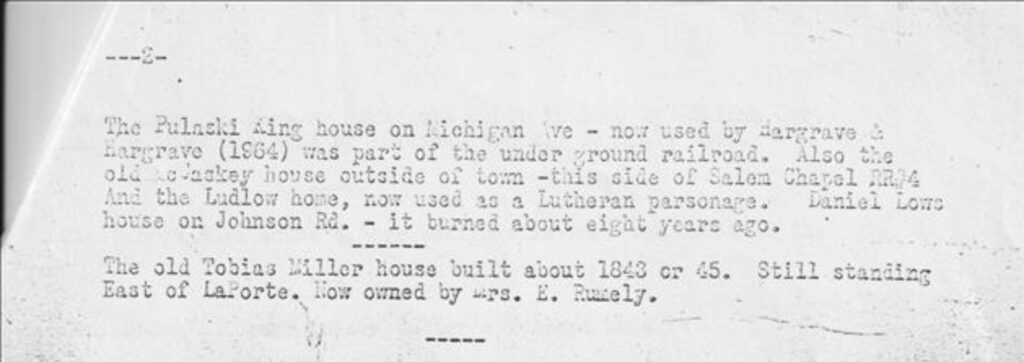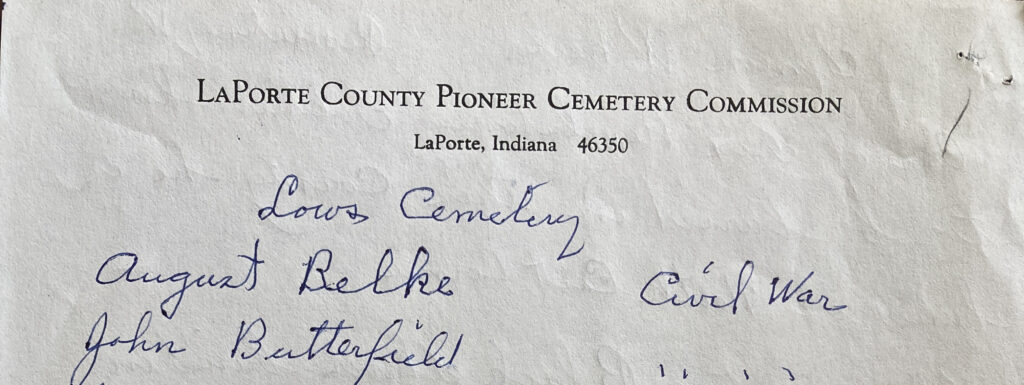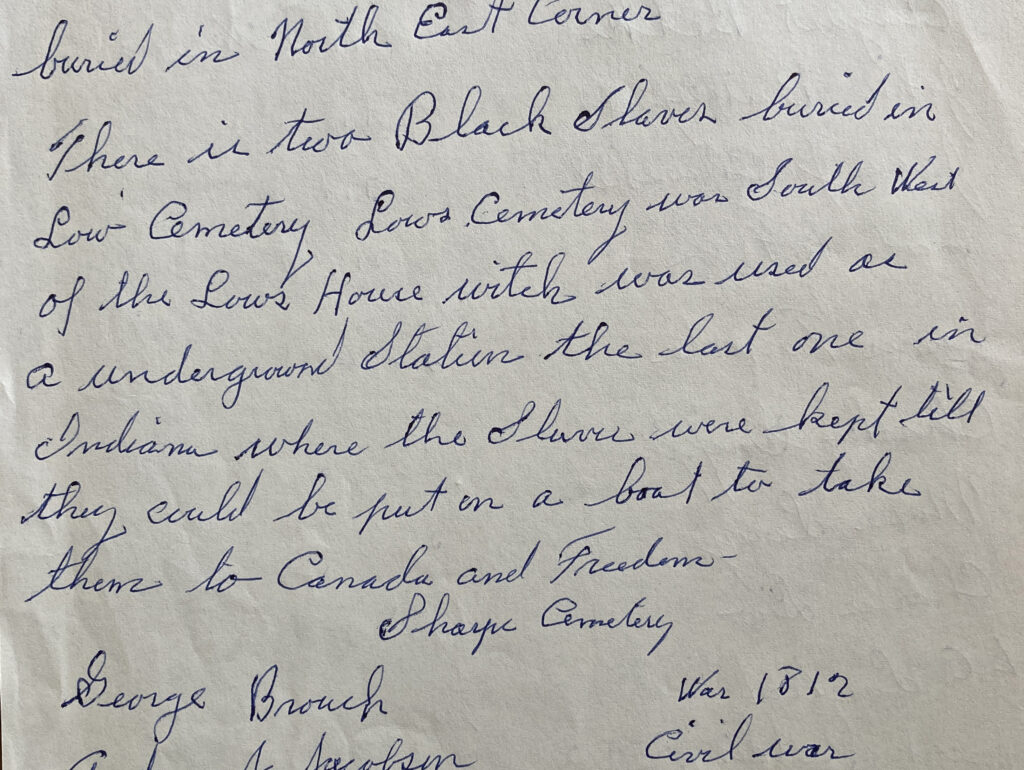There is a fantastic story of a man named Daniel Low who guided 150 runaway slaves to freedom in northern Indiana. Lit candles on the widow’s walk atop his house instructed fugitives when it was safe to travel. Two ill fugitives died and were buried in Low’s own cemetery. His home was fugitive slaves’ last stop before being stowed aboard boats in Michigan City’s harbor and floated to Windsor, Canada. It is a good story and it most likely is a myth.
Low’s story claims that fugitive slaves traveled west from Plymouth, Indiana, through Walkerton, Stillwell, and LaPorte to Daniel Low’s house in Coolspring Township before moving at last to Michigan City, into Lake Michigan via the harbor, then traveled north apparently through the Mackinac Straight and then south to Windsor, Canada.
W.H. Siebert’s work on the Underground Railroad (UGRR) is the preeminent research on the subject. In the mid-1890s, he mailed inquiries across the country asking for UGRR information. He received thousands of replies and the archives holding his work are a treasure trove of information. When he published his book, “The Underground Railroad from Slavery to Freedom, ” he included the following map on page 138:
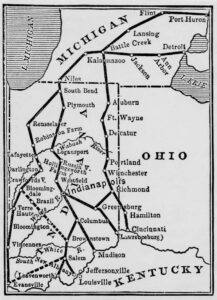
Notice that Northwest Indiana is devoid of paths in this map. That’s because the Grand Kankakee Marsh cut off this area from the rest of the state. Encompassing roughly 1 million acres, the marsh was treacherous and difficult to travel. It was so difficult that the northwest residents of Pulaski County appealed to the Indiana State Legislature to become part of LaPorte County to the north because the marsh made it nearly impossible to reach their own county seat and courthouse. The legislature changed the county line to run along the Kankakee River in 1842, putting four townships from Starke County into LaPorte County.
Some people point to another map published by Siebert that shows a path that appears to cross Michigan City, Indiana, as supporting evidence of the Daniel Low UGRR story. Here is a cut-out from that map.
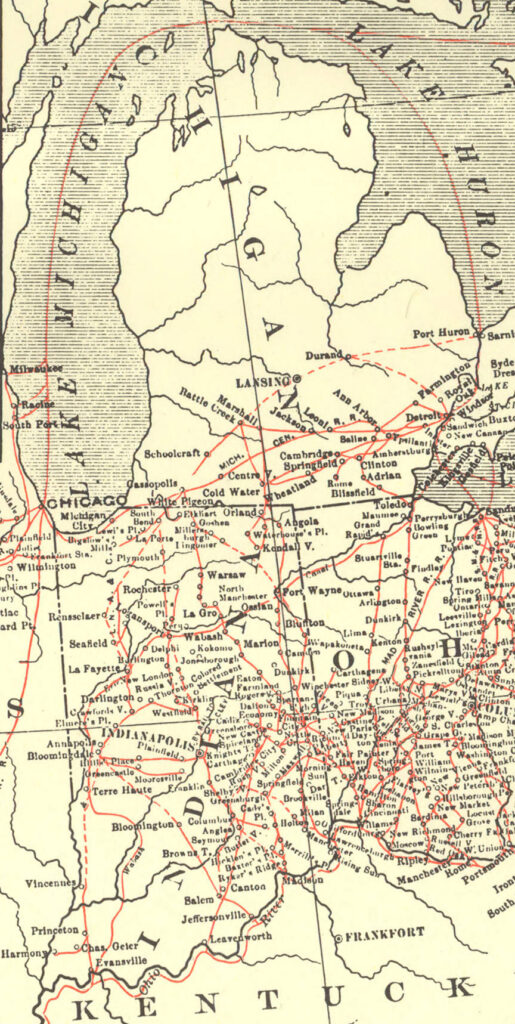
This map demonstrates the impediment the Grand Kankakee Marsh presented as all lines go around it. Furthermore, it shows two land paths running west-to-east from Illinois through Indiana into Michigan and onto Detroit and Windsor. Neither map shows a Plymouth-to-Michigan City route and neither path passed by Low’s Coolspring Township home.
After the Civil War, people began to tell stories of their involvement in the UGRR. For example, in 1876, Levi Coffin published his autobiography, “Reminisces of Levi Coffin: The Reputed President of the Underground Railroad,” detailing his significant involvement.
If Daniel Low were as heavily involved in the UGRR as the story written about him claims, his activity would have surfaced in the late 19th century or early 20th century. The following books/papers/people would have mentioned Daniel Low’s involvement with the Underground Railroad:
- 1876 – Packard, Jasper, “History of LaPorte County, Indiana, and Its Townships, Towns and Cities.”
- Packard cited Daniel Low among the names of people for “furnishing valuable information” to help gather this history.
- 1880 – Chapman, Charles, “History of LaPorte County, Indiana.”
- It includes a lengthy exposé of Low, Low’s portrait, and a drawing of Low’s home and farm.
- 1882 – Daniel Low died and left no record of his involvement in the UGRR.
- 1890 – Mary (Barker) Low, Daniel Low’s wife, died and left no record of their involvement in the UGRR.
- 1898 – Siebert, Wilbur H., “The Underground Railroad from Slavery to Freedom.”
- 1899 – Dakin, Esse, “The Underground Railroad” (presented to the Northern Indiana Historical Society).
- 1902 – Charles Otis Low (Daniel’s son) died.
- 1904 – Daniels, E.D., “A Twentieth Century History and Biographical Record of LaPorte County, Indiana.”
- 1908 – Oglesbee, Rollo, “History of Michigan City, Indiana.”
- 1924 – Mary E. (Low) Mudge (Daniel Low’s daughter) died.
- 1930s – Works Progress Administration, “Underground Railroad: The Invisible Road to Freedom Through Indiana.”
- 1939 – Windle, Helen, “The Underground Railroad in Northern Indiana, Based on Personal Narratives & Famous Incidents.”
Not one of these sources mentioned a Daniel Low connection to the Underground Railroad. Furthermore, researchers have uncovered zero records of a community leader, neighbor, friend, family member, political ally or opponent of Daniel Low mentioning his connection to the Underground Railroad while he was alive or in the decades immediately following his death.
When W.H. Siebert’s requests for information spread across the country, two of Low’s children were alive. Not they, nor anybody else, responded to Siebert mentioning Daniel Low or the Plymouth-to-Michigan City route.
The first-known mention of Daniel Low’s involvement in the UGRR didn’t occur until August 24, 1964—99 years after the Civil War ended. A typed mimeographed paper titled “Things to Remember Told by Gene McDonald” is in the local history collection of the Michigan City Public Library. Among other unrelated notes, the document stated, “The Pulaski King house on Michigan Ave – now used by Hargrave & Hargrave (1964) was part of the under ground [sic] railroad. Also the old McCaskey house outside of town – this side of Salem Chapel RR#4 And the Ludlow home, now used as a Lutheran parsonage. Daniel Low house on Johnson Rd. – it burned about eight years ago.” The typist is unknown.
Another copy of a typed sheet of paper in the LaPorte County Historical Society archive states, “The route of the underground railroad in the Civil War. Walkerton to the Jacob McCaskey house, from there to Pulaski King house (Hargrave and Hargrave) then to Orville Buck – to Low house, then to Michigan City or New Buffalo up into Michigan. Gene McDonald-1969 MGK.” The typist probably was Madeline G. Kinney, LaPorte County Museum curator.
In the Michigan City Historical Society archive, there is a handwritten note on LaPorte County Pioneer Cemetery Commission letterhead that states, “There is two Black Slaves buried in Low Cemetery. . . Lows House witch [sic] was used as a underground Station the last one in Indiana where the Slaves were kept till they could be put on a boat to take them to Canada and Freedom.” It may be Gene McDonald’s handwriting, as he was pioneer cemetery board president at one time, but no name is present.
In August 1975, Gladys Bull Nicewarner wrote a paper titled, “Low Cemetery – Coolspring Township.” It included the first-known full-length account of Daniel Low as UGRR station agent. Nicewarner repeated the account in her 1980 book, “Michigan City, Indiana: The Life of a Town.”
Nicewarner wrote the sensational story of Daniel Low, that two ill slaves died and were buried in Low’s cemetery, candles were lit on the widow’s walk atop Low’s house if it was safe for fugitive slaves to travel, they were smuggled aboard grain boats in the Michigan City Harbor to Windsor, Canada, and that 150 slaves passed through Low’s station. Nicewarner mentioned a source of this information: family lore passed down to Gene McDonald from his mother.
Nicewarner wrote, “It is believed that approximately one hundred and fifty slaves were transported from Low’s station.” Five years later in her book, she dropped the word “approximately.” She did not provide a source for this information or explain how that figure was derived. McDonald’s story from his mother never stated that she had first-hand knowledge of Low’s involvement in the UGRR. Nicewarner’s story has been repeated multiple times in writing, oftentimes word-for-word.
According to McDonald’s story, his mother and aunt came across a farmer and hay wagon near Low’s house with slaves hidden aboard. The girls were on their way home from singing school and the farmer threatened them if they told anybody what they saw. Healthy skepticism should lead us to ask, if the fugitive slaves were hidden, how did the two girls see them? An alternative story could be that a farmer saw the two girls and thought he’d have a little fun by scaring them with a tall tale of runaway slaves hidden onboard. Regardless, it’s difficult to ascertain the truth and this is not enough to implicate Low’s involvement in the UGRR.
Coincidentally, Gene McDonald compiled a 43-page booklet, “The History of Pioneer La Porte County,” in the 1960s. It was printed by the office of the LaPorte County Superintendent of Schools and it does not mention Daniel Low’s UGRR work. It did mention another man who resided in Coolspring Township who supposedly milled 200 barrels of flower per day during the Civil War, but no UGRR activity.
In the report, “Low’s Cemetery: Incomplete List of Burials,” compiled in 1997 by former LaPorte County historian Fern Eddy Schultz, Patricia Harris, and Holly Jenks, there are four unmarked graves in the cemetery. The report indicated they all belonged to Civil War veterans.
Despite the lack of credible source material, there are other problems with these tales. Daniel Low’s house with the important widow’s walk was not built until 1858. The Pulaski King house in LaPorte (allegedly on this same UGRR route as the Low home) also had a widow’s walk and wasn’t constructed until 1860. This tale has a troubling pattern—the McCaskey house near Stillwell, also on the alleged Plymouth-to-Michigan City UGRR route, had a widow’s walk too. That’s a short period of time for so much traffic to pass undiscovered. None of these homes were implicated in the UGRR until 100 years after the Civil War ended.
Furthermore, a quick study of the men who worked on the wharves and boats of the Michigan City harbor makes it difficult to believe that enough of them would have cooperated with this scheme to avoid incident. Surely, one of the dock wallopers, as they were known, would have seized the opportunity to collect the reward by reporting or returning a runaway if they had known a fugitive slave was in their midst.
In Fred Karst’s 1971 article[1], “Engineered by Quakers: The Underground Railroad in Northern Indiana,” he described the alleged Plymouth-to-Michigan City route that featured homes with hidden tunnels and rooms. His article incorporated two of the most common myths about the UGRR according to Henry Louis Gates (#1 and #3). There is no evidence in Indiana of UGRR tunnels, secret rooms, and false walls according to expert Jeannie Regan-Dinius (February 2023). Karst also mentioned McDonald as a source in his story.
To ascertain the truth about Daniel Low and the Underground Railroad in LaPorte County, one can look at the Indiana Department of Natural Resources, Division of Historic Preservation and Archaeology report published October 2003: “Underground Railroad Research in Select Indiana Counties.” DNR researchers included Glady Bull Nicewarner’s story about Daniel Low’s alleged UGRR activity and concluded, “Identification of runaway burials in the Low Cemetery has not been verified in any other source or via exhuming. For now, these stories can only be seen as local legend.” (Strangely, a current DNR web page contradicts what its own researchers determined in 2003).
Although newspaper articles repeated the sensational tale about Daniel Low and the UGRR, none apparently examined its veracity. I don’t think Gladys Bull Nicewarner, Fred Karst, or Gene McDonald acted with bad intentions; rather, their imaginations and confirmation bias got the best of them.
One theory is that McDonald fully believed his mother’s childhood story as most of us are wont to do. He knew the UGRR didn’t pass through the Grand Kankakee Marsh because it was treacherous to traverse and the Yellow River Road from Plymouth to LaPorte was a common route around it. He read about Plymouth UGRR traffic and heard a tale about slaves stowing away aboard boats in Michigan City. When he spotted homes with architectural features such as widow’s walks and odd basements between Plymouth and Michigan City, he interpreted that as evidence of UGRR activity, rather than coincidence. (Widow’s walks were not uncommon features in LaPorte County).
It all does make for a good story. However, to date, no evidence has surfaced that provides credence to the Daniel Low UGRR station agent narrative. Based on available evidence, the story originated with family lore that didn’t surface until 100-plus years after the activities allegedly occurred. Maybe evidence will turn up one day. Without credible sources or evidence, this story most certainly is a myth.
Copyright Matthew A. Werner 2023
[1] The article may have been rerun. One source cites this article published May 30, 1971. A handwritten note in the LaPorte County Museum archives suggests it was published in a Tribune special Sunday insert, “Michiana Memories,” in 1980.
